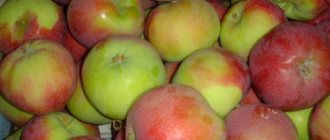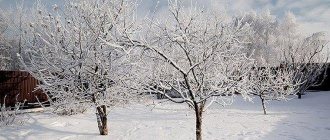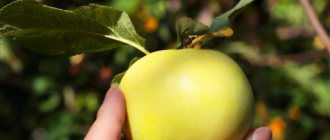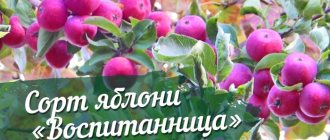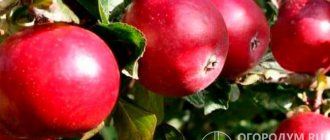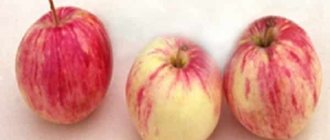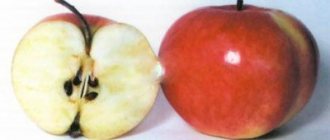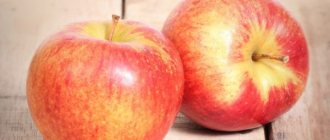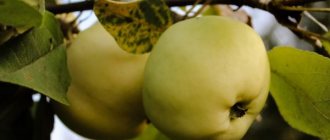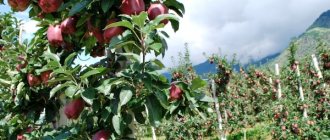Description and characteristics of the variety
The description of the variety states that Geneva is one of the earliest summer varieties. The apple tree is productive, and the fruits are tasty and beautiful. The pulp has a pleasant taste and consistency. The tree is of medium height; the angle of inclination of the branches depends on the trunk, its variety and correct formation.
Advantages and disadvantages
A number of advantages make this apple tree variety in demand. Important characteristics are:
- early big harvest;
- beautiful tasty fruits;
- precociousness;
- resistance to return frosts.
The disadvantages are the short shelf life. But this indicator is typical for summer varieties.
Productivity
Although the fruits are quite small, sometimes reaching a weight of 150 grams, the harvest from the apple tree is quite large. About 130 kg of apples can be harvested from one tree.
The apple tree blooms profusely, the inflorescences are large and fragrant. There are many ovaries and they turn into green-red fruits with a balanced sweet and sour taste.
Pollinators
The variety needs to be planted with pollinators within reach. They should bloom at the same time as the Geneva apple tree. These include James Grieve, Idared Delicacy and all their hybrids. Pollinators can greatly increase the number of ovaries.
Drought resistance and winter hardiness
Although resistance to low temperatures is considered high, this is indicative of cultivation in the middle zone. But under conditions of certain protection, the apple tree can be planted in the harsh Siberian latitudes.
Apple tree in winter.
Drought resistance is average. A fruit crop can develop in conditions of lack of moisture, but this will negatively affect the amount of harvest. It is better to water an adult apple tree several times during the season.
Resistance to pests and diseases
The apple tree has good immunity to various diseases of apple crops. But scab is an exception. It is from this that Geneva suffers the most in humid summer conditions.
Pests on the apple tree, although rare, do appear. It is necessary to carry out preventive measures against them in the spring. During the season, you should check the condition of the fruit crop and, in case of infection, immediately proceed to protective measures.
Transportability of the variety
The skin of the fruit is very thin and fragile. That is why it is almost impossible to transport the harvested crop over long distances. Fruits can be stored in wooden boxes for a short time, but this will not last more than two weeks. The apple tree variety is not cultivated for commercial transportation.
Diseases and pests
Although resistance to powdery mildew is quite high, the apple tree must be protected from fungal diseases. To do this, spray with copper-containing preparations. The procedure is carried out before buds open, after flowering and in the fall, after harvesting.
Powdery mildew on an apple tree.
It is also important to carry out pest control procedures. Remove and mulch the trunk circle, whiten the trunk twice a season, and form a crown. In the spring, also for prevention, you need to spray with Karbofos or Aktara.
Resistance to frost and pests
The Geneva apple tree variety has very high resistance to frost, so it grows without any problems even in cold summers. Very often you can find this variety in the northern regions, and there it also develops well.
When creating the variety, it was given a strong immune system, so it is not afraid of more diseases and viruses, since it is resistant to them.
The only thing that the Geneva apple tree variety can become infected with is scab. But it appears only with improper care or lack of care.
Planting seedlings
An important condition when planting is the correct choice of location and planting material. It is important to choose a place in the sun, but away from wind and moisture. The seedling should be comfortable and have plenty of space so that the crown has room to grow.
Deadlines
Depending on the climatic conditions of the region, planting can be carried out in spring or autumn. Spring planting is carried out when the soil has already thawed and warmed up. With this planting, the seedling will have time to take root well in the soil and become sufficiently strong before winter.
If seedlings are planted in the fall, they must have time to be moved into the ground a month before the onset of cold weather. This planting is preferable in those regions where winters are quite warm and the soil is fertile. The seedling will have time to take root over the winter, and the fruit trees will begin to grow faster in the spring.
Technology
When planting, you need to take care to choose a peg for support and take several buckets of water for watering.
Planting an apple tree.
The planting technology is quite simple:
- the area where the apple tree will be planted needs to be cleaned and leveled;
- dig a hole of a suitable size and leave the top layer of fertile soil from it;
- place pebbles or crushed stone at the bottom to create drainage;
- mix fertile soil, ash, compost and humus, mix and place in a hole;
- install a seedling in the middle and straighten the roots;
- sprinkle with soil and compact;
- make sure that the neck of the root is above the ground level;
- water and make a roller in the tree trunk circle.
This event is held on a day when the weather is sunny, warm and stable.
Apple tree Geneva: planting varieties
Before planting a Geneva apple tree, you need to do some preliminary work. They consist in choosing a location, preparing the soil, and choosing a seedling. Soil preparation is considered especially important, since it determines how well the apple tree will take root and what kind of harvest it will produce.
What time to plant Geneva apple trees?
Geneva apple trees are planted in spring or autumn. Planting is not carried out in winter and summer.
It is best to plant in the autumn, since during the winter the seedling will take root and take root at the planting site, and with the onset of spring the seedling will begin an active growth phase. Planting in spring also has the advantage that the plant will become stronger over the summer and winter frosts will not harm the young seedling.
Planting in spring should be done only after the soil has warmed up. This happens after several hot days, when the snow has already melted. Apple tree planting begins in early May.
Note: If planting was carried out in the spring, then the apple tree should be well watered.
Landing place.
The planting site should have good fertile soil. Light, loose soils that are filled with useful microelements are well suited. This place should be well lit by sunlight and Geneva should not be planted in the shade, as development will slow down. Also, the shadow will contribute to the deterioration of the functioning of the apple tree, the harvest may become smaller, and the taste and appearance of the apples will deteriorate.
Before planting, the soil must be prepared. To do this, mineral or organic fertilizer is added, for example, wood ash or dolomite flour.
Instructions for planting the Geneva apple tree variety.
- First you need to dig a hole about 80 centimeters deep and 90 centimeters wide. The hole should correspond to the size of the seedling's root system.
- A small layer of earth mixed with manure and wood ash should be placed on the bottom.
- After which the pit is left for 12-15 days.
- In the center you need to install a pole that will serve as a support for the apple tree.
- The root system of the apple tree must be treated with a growth stimulator before planting.
- Also, before planting, the roots are soaked in water with clay.
- The root system is installed on a mound of earth.
- The earth is poured on top and compacted well.
- After which you need to thoroughly water the plant. When planting in spring, watering should be regular, but in small quantities.
Apple tree Geneva: photo of variety
Care
For normal development, the Geneva apple tree needs proper, stable, complete care. With such care, the apple tree will only become more beautiful, the taste of the fruit will be richer and juicier.
Watering
Although the apple variety is resistant to drought, it is better to water it in a timely manner. A sufficient amount of moisture will have a positive effect on the condition of the fruit, the appearance of the fruit and the taste of the apples; they will be larger and more juicy.
The process of watering an apple tree.
The irrigation scheme is as follows:
- in the process of shoot formation and bud opening;
- during flowering;
- watering during fruit ripening;
- at the end of the harvest, before the onset of cold weather.
A young apple tree needs to add 10-15 liters of water once. Adults will need twice as much.
Top dressing
During the season, fruit trees are fed regularly. They are not introduced only in the first year after planting.
The schedule is like this:
- The first application is carried out after the buds open. You will need nitroammophoska, urea or humus.
- During the flowering process, complex fertilizer is applied.
- Before you start filling the fruit, in the summer, you need to add potassium and a little nitrogen. It is important to fertilize the roots in the evening, when the heat subsides.
- In the fall, potassium is added to the tree trunk, which will help the apple tree prepare for winter.
The video will tell you in more detail how and with what to fertilize fruit crops during the season.
Pruning and crown formation
Like any other apple trees, the Geneva Early variety needs regular sanitary pruning and crown formation. In the first years, the top conductor is cut off to stimulate the growth of lateral shoots. Next, you will need to cut off those shoots that form the trunk in order to make a tiered crown.
The process of pruning an apple tree.
In order for an adult tree to develop normally, and for all apple trees to have enough sun and the branches to be ventilated, it will be necessary to remove those shoots that grow inward, thicken the crown and are not beneficial.
For sanitary purposes, remove all those branches that are damaged by cold weather and insects. All frozen and damaged shoots are removed so that the apple tree’s immunity is not damaged.
Preparing for winter
Although the hardy variety can tolerate cold temperatures, it must be covered and protected. The trunk circle is loosened and covered with spruce branches, and the trunk of the apple tree is whitened. If the seedlings are still young and short in stature, then they need to be covered completely with agrofibre or burlap. In the spring, the shelter is removed and everything is removed from the tree trunk circle so that the soil thaws faster.
Loosening and mulching
After watering, the tree trunk circle must be loosened. The procedure must be carried out carefully so as not to damage the young roots, which may be located close to the ground. This is done so that the roots have access to moisture and water.
Mulching will make caring for the tree trunk easier. A layer of covering material will help prevent weeds from appearing, insulate the roots and retain moisture. Compost, dry grass, pine needles, sawdust, small branches and shavings are suitable for mulching.
Mulching the tree trunk circle.
Diseases and fertilizers
The Early Geneva apple tree, which must be cared for regularly, needs protection from many diseases: scab, powdery mildew and others. It is quite resistant to brown spot. To prevent diseases, trees are fed with mineral fertilizers immediately after planting. In the first year, nitrogen is added. The first time in May, the second in June. By autumn you will be able to notice powerful growths that form the future crown. If growth is too intense in the first year, then the amount of fertilizer should be reduced next year. In subsequent years, the amount of fertilizer is reduced to a minimum in order to start the fruiting process.
In the first years it is impossible to do without chemical protection. There are a lot of different products for treating the crown and roots that are easy to buy in the store.
It is definitely worth protecting the tree from various rodents. Periodically, the leaves are sprayed with Bordeaux mixture.
How to plant an apple tree in the spring correctly? Thanks to this procedure, you can not only experiment, but also significantly save space in the garden. Spring is the most favorable time for grafting plants. It is during this period that the beginning of sap flow is noted, which accelerates survival. If the scions do not take root, you can try to do this again in the summer.
There are many different ways to plant an apple tree in the spring:
Do not forget that grafting an apple tree is a kind of operation, so be sure to wash your hands before the procedure. After 10-15 days, you need to check the grafting site. Has the graft taken root, are there any consequences? Do not forget about gradually loosening the bandage at the vaccination site. All shoots below the graft are removed. Grafted trees need timely watering and fertilizing.
Many gardeners have already appreciated the merits of the Airlie Geneva apple tree. There are, of course, other very early varieties, but this one has a pleasant taste and can be stored in the refrigerator for several days. Extended ripening is also very convenient, when apples ripen not simultaneously, but gradually.
The Geneva Early apple tree, according to reviews, produces fruits that are widely used in cooking. It has a fairly high and stable yield.
Apples contain a very large amount of vitamins and microelements, which is why early varieties are so valued. There is an opportunity to replenish the body with new reserves as early as possible. Also, fruit lovers and connoisseurs will be happy to feast on apples, while in other areas the first fruits have not yet ripened.
One of the advantages of this variety is that they can be stored in the refrigerator, although not for a long time, but still longer than White filling.
Apples are distinguished by their pleasant sweet and sour pulp of medium hardness, as well as a bright red blush. They can even be transported rather than immediately recycled. The temperature should be low.
Gardeners noted that this variety tolerates winter frosts and summer drought quite well.
If you follow simple recommendations, then literally a year or two after planting you can taste the first fruits of this apple tree. The variety is high-yielding and regularly pleases gardeners with delicious fruits. All the efforts that will be spent during planting and caring for the tree will not be spent in vain. The tree will generously thank the gardener with its harvest.
Features of ripening and fruiting
The variety is early, and flowering can usually be observed in early May. Fruit picking can begin at the end of July, sometimes in early August. But the ripening period is uneven; collection will need to be carried out in several stages.
The fruits are small, round, yellow-green, with a red blush on most of the fruit. Geneva is a fast-growing variety and bears fruit already in the third year of life. Productivity is annual, without pronounced cyclicity and dormant periods.
The shelf life of fruits is short, up to two weeks. They make delicious jams and compotes. A slightly slight sourness makes Geneva apples the best for juicing. They are often baked with honey and sugar.
The photo shows a ripe Geneva Early apple.
History of selection
The Early Geneva apple tree was bred in 1964 in Geneva by breeders representing the New York State Testing Station. Scientists tried to cross-pollinate Cuban varieties, which have bright and large fruits, with pollen from apple trees growing in Switzerland and bearing fruit in July, using material from the Julired and Quinti varieties.
Did you know? Apple trees are considered quite long-lived trees: cultivated varieties live up to 100 years, and in the wild there are plants with a considerable age - from 150 to 300 years.
These varieties ripen early and have adaptations to cool climate regions. As a result, scientists received about 200 seedlings, which underwent variety testing in 1973. Among them, one variety with the number NY 444 was called Geneva Early. Gardeners began to grow the variety described in public since 1982.
Adviсe
The average height variety Geneva grows up to 5 meters. And there are no dwarf or columnar subspecies. To grow an apple tree fully, you need to follow all the principles of agricultural technology. It is very important to consider that the variety is susceptible to scab, but is not afraid of other fungal diseases.
In conditions of prolonged humidity, it is important to regularly inspect the plantings for the first signs of disease. If symptoms appear, immediately proceed to spraying. This is a varietal characteristic, feature and description of the Airlie Geneva apple.
Reviews
Marina, 46 years old, Crimea: “We planted Geneva in the spring that year, it immediately began to grow and was completely covered with buds. We cut them off so that the apple tree would take root well. I’ll add reviews when we reap a big harvest.”
Leonid, 38 years old, Saratov: “The Geneva Air apple tree is good for everyone, it bears fruit early, ripens early and the fruits are beautiful and large. I think they are a little sour, but the kids like them. My wife makes a lot of things from them: juice, drink, jam.”
Alevtina Fedorovna, 56 years old, Ryazan: “The fruits are very tasty, I like them. They are one of the first to ripen on the site. But the tree is very sick with scab, we have to constantly monitor it.”
